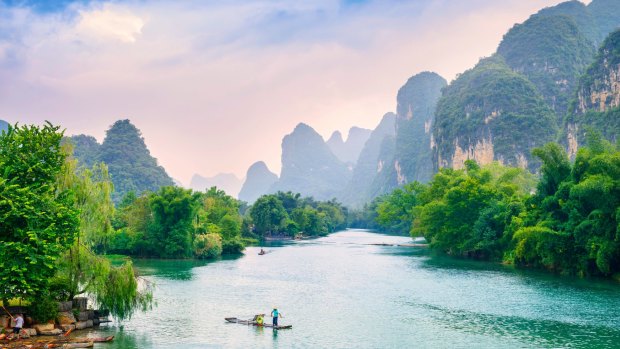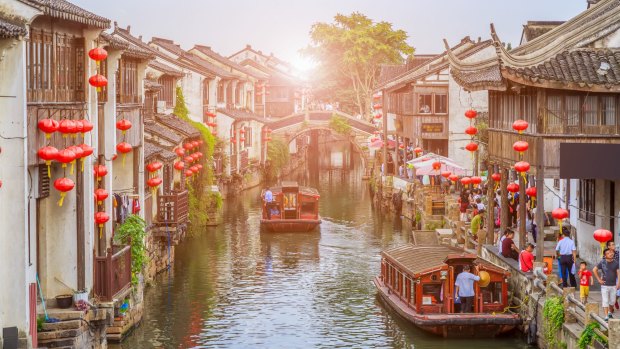This was published 5 years ago
China: Visit China's smaller towns and cities for culture, scenery and relaxation

The Li River and Karst Mountains, near Guilin, China.Credit: SHUTTERSTOCK
In a vast land with several millennia of history and an eagerness for superlatives, most visitors to China have a hard-enough time just keeping track of big walls, terracotta warriors and which skyscraper is now the nation's tallest. How many people beyond China have even heard of Jiangsu Province on the east-central coast near Shanghai? Probably not many, and yet it's China's wealthiest and most densely-populated province, and it alone has a nation's-worth of cultural relics and mid-sized cities that ought to be world famous.
Everyone knows X'ian thanks to its terracotta warriors, but kudos if you're familiar with Xuzhou, a stop in Jiangsu Province on the high-speed train line between Shanghai and Beijing. Here, you can admire one of China's unsung wonders, another set of soldiers and horses that dates from the second-century BC Han Dynasty. The 4800 figures, much smaller than life size and arranged in battle formation, were excavated from the tomb of a local king. Some wear armour and carry crossbows.
Xuzhou – which has a population of a mere three million – is only one of Jiangsu Province's minor cities boasting fabulous cultural relics. Also worth the train journey stop-off is Wuxi, an ancient tin-mining town and port on the Grand Canal that faces vast Taihu Lake, perhaps China's most famous lake. It's the source of the fantastically weathered limestone rocks you often see in classical Chinese gardens. Ferries take sightseers out on the lake, which is often misty. Alternatively, climb up the two hills of Xihui Park to pagodas that provide pretty outlooks.

The ancient town of Suzhou, China .Credit: SHUTTERSTOCK
This area west of Shanghai is noted for its many water villages. Across on the southern shore of Taihu Lake is what might be the prettiest, Nanxun. It features all the stereotypes of old China, from ancestral halls hung with red lanterns to cobblestone lanes and half-moon bridges. Pleasant canal-side walkways are made for strolling.
The most famous town, though, is Suzhou – still considered a minor city in China despite being home to some 10 million residents. It's an easy daytrip from Shanghai, though actually a more pleasant place to overnight. Nicknamed the Venice of the East for its many canals and surrounding moat, Suzhou was probably the world's wealthiest city during the Ming Dynasty and is dotted with aristocratic, now World Heritage-listed, gardens. Though compact in size, their impeccable arrangements of rocks, pavilions and walkways provide changing vistas that make the gardens appear larger, and provide corners of tranquillity despite visitor numbers. Among the most famous is the 16th-century Garden of the Humble Administrator, where a series of pools is connected by stepping-stone pathways and humped bridges. In summer, fragrant lotus flowers bloom on the ponds and dragonflies flit.
The city's other great cultural attraction is the Museum of Suzhou, housed in a striking modern building designed by I.M. Pei, most famous for his Louvre pyramid. It's a repository of tens of thousands of works, including ceramics, jade, textiles and sculptures from Suzhou's great flowering as a scholarly and artistic centre, and certainly proof that you don't have to head to China's biggest cities for the best museums.
Suzhou is, incidentally, another stop on the high-speed train line towards Beijing, as is Jinan much further north. Like most Chinese cities, Jinan is busily bursting upwards and outwards, but dozens of natural springs have created blue pools and lakes that are still surrounded by pockets of neighbourhood tranquillity where locals practice tai chi and live in little alleyways. The city has fine museums, too, such as Jinan Museum for ceramics and calligraphy, and the vast Provincial Museum for fabulous objects from China's long history, including pottery that is 3000 years old.
Although Jinan remains virtually unknown outside China, its population is a hefty seven million. Even the smallest of places in China, though, are crammed with amazing relics. Pingyao in Shanxi Province, about halfway between Beijing and Xian and managing only 50,000 inhabitants, is the country's best-preserved 18th-century Qing Dynasty town, and one of the most delightful places in China. Although it's a mere newcomer by Chinese standards, its importance as an early banking centre has graced it with impressive mansions, civic buildings and six-kilometre city walls from which you can peer down onto dragon-draped temple roofs and into courtyards, where ears of corn are strung out to dry.
Further south, Kaifeng had its heyday a thousand years ago as China's imperial capital, when it was likely the world's largest city, with an estimated 700,000 inhabitants. (Today it's a minnow with just five million.) Its oldest building, Fan Pagoda, was built in 997, and is just one of dozens of pagodas, temples and pavilions dotting the old town. Costumed craftspeople enliven a recreated and very enjoyable Song Dynasty village. But Kaifeng, like many smaller cities, is also worth visiting for its contemporary liveliness, with busy evening street markets selling everything from gadgets and pop-idol posters to chilli crab and lamb skewers.
Not all of China's provincial cities are completely overlooked by overseas visitors, of course. The most famous is probably Guilin in the southwest, with a population of about five million. The city itself has more concrete than elegance, but from within the city limits you can see some of the spectacular land formations so lauded in classical Chinese painting and poetry. A teahouse atop cave-riddled Whirlpool Hill rewards you with fine outlooks over the Li River and the improbable humped hills that line the horizon like a child's drawing. Other urban peaks also provide good views, such as Solitary Beauty Peak, where you'll also find the remains of a 14th-century palace.
All around Guilin, splendid camel-hump mountains, sometimes topped with pagodas, rise out of shimmering green rice paddies, and are looped through by muddy rivers in the kind of scenes you see painted on Chinese scrolls. Take the 80-kilometre boat ride down the Li River to soak up the scenery, and consider staying in Yangshuo – population just 300,000 – for one of China's loveliest country retreats. The charactered old town sinks into country tranquillity after the many day-trippers from Guilin have vanished in clouds of coach fumes. The surrounding landscape of karst piles and lush green valleys pushes right up against the town.
You won't find such scenery anywhere near China's megacities, except Chongqing, from which cruise ships sail into the Yangtze River Gorges. Setting – and an escape from grey smoggy skies – is another advantage to visiting smaller destinations. Kunming, the capital of Yunnan Province (population seven million), is protected on three sides by mountains and opens onto Dianchi Lake. The city has long been renowned among Chinese for its scenery, mild climate and seemingly perpetual sunshine, as well as its abundance of flowering camellias and azaleas.
For centuries, the city straddled trade routes between China, India and Southeast Asia, and today it bustles with thriving commercial districts and universities. For visitors and picnicking locals, its scenic Western Hills high above the lake, dotted with temples and forests, are a prime urban getaway.The scenery gets ever more splendid and the towns smaller as you head northwest. Dali, home to under a million, sits at 2000 metres above sea level on the shores of a mountain lake. The old town of stone and wood has two massive city gates that guard the road to the mythical mountains of Shangri-La beyond. This was once the capital of the powerful eighth-century kingdom of Nanzhao, and is notable for its three pagodas, built of brick coated in white mud between 823 and 1108, and testament to the long history of Buddhism in the region, carried across the mountains from India.
Another 200 kilometres north, deeper into the edge of the Himalayas, is Lijiang, whose population has now swelled to well over a million. Still, at its core sits a delightful alpine old town alive with street markets where the Naxi minority people haggle over cabbages and carrots. On the edge of town, Jade Spring Park is dotted with venerable monastic buildings. Moon-Embracing Pavilion is reflected in a small lake, framed in weeping willows and backed by snow-capped mountains, and a very long way from megacity madness.
Brian Johnston frequently travels to China at his own expense.
IF YOU MUST HAVE A MEGACITY …
SHANGHAI
Few cities can match forward-looking, futuristic-looking Shanghai, ultimate symbol of China's economic dynamism. It has colonial-era districts, traditional gardens and temples, but it's the shopping, dining and street life that really count. See meet-in-shanghai.net
WUHAN
This sweltering city, with its great riverside promenades, is the port for cruises into the Yangtze River Gorges. Its biggest attraction is Hubei Provincial Museum, displaying stunning artefacts unearthed from an aristocratic 400 BC tomb. See en.hubei.gov.cn
TIANJIN
Emerging in the early 15th century, Tianjin flourished as a foreign concession and seaport for Beijing just a 90-minute train ride away. It has European-influenced architecture, fine river promenades, temples and interesting museums. See en.tjtour.cn
GUANGZHOU
The city formerly referred to as Canton is a boomtown, but also dotted with venerable temples and associated with China's revolutionary history. It has a famous cuisine, excellent shopping and eye-popping contemporary architecture. See gz.gov.cn
BEIJING
It may be a mega-city, but Beijing also has 500 years of heritage as China's capital and some of the country's top sights, including the Forbidden City, Summer Palace and easily accessed sections of the nearby Great Wall. See visitbeijing.com.cn
TRIP NOTES
MORE
FLY
Air China (airchina.com.au), China Eastern Airlines (oa.ceair.com), China Southern Airlines (csair.com), Hainan Airlines (hainanairlines.com), Sichuan Airlines (sichuanair.com), Tianjin Airlines (tianjin-air.com) and Xiamen Air (xiamenair.com) all fly between Australia and Chinese cities.
Sign up for the Traveller Deals newsletter
Get exclusive travel deals delivered straight to your inbox. Sign up now.